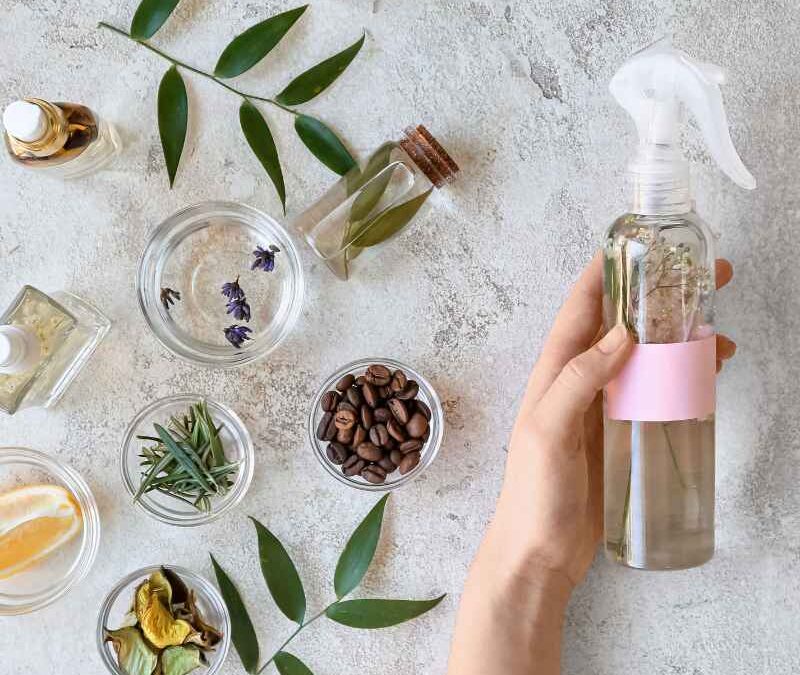Crafting Your Own DIY Essential Oil Room Spray
A Step-by-Step Guide
Are you ready to transform your living spaces into aromatic havens of tranquility and well-being? Crafting your own DIY essential oil room spray is a delightful creative endeavor and a fantastic way to embrace the power of aromatherapy. In this guide, I’ll walk you through the process of crafting your own personalized DIY room spray sharing my expertise as a certified aromatherapist. These DIY room sprays are so easy you can make one for each room of your home, and one for the office as well. Let’s get started!
Understanding Essential Oils
What Are Essential Oils?
- Essential oils are highly concentrated plant extracts obtained from flowers, leaves, bark, and roots through a distillation process. The distillation process typically involves steaming or cold pressing the plant matter.
- Essential oils capture the essence and aroma of plants, offering a natural and holistic approach to well-being.
Therapeutic Properties
- Essential oils have a range of therapeutic properties, including relaxation, mood enhancement, and stress relief.
- They can also provide respiratory benefits and support overall emotional balance.
Benefits of DIY Essential Oil Room Sprays
Creating your own room sprays comes with several advantages:
- Customization: Tailor your room sprays to your preferences and needs.
- Natural Ingredients: Avoid harsh chemicals and artificial fragrances.
- Cost-Effective: DIY room sprays are budget-friendly compared to store-bought alternatives.
- Eco-friendly: Using essential oils and other natural ingredients as well as reusing the spray bottle makes DIY room sprays a win for the environment. Just make sure you are purchasing your essential oils from a supplier who values sustainable sourcing.
Essential Tools and Ingredients
To get started, gather the following:
Tools and Equipment
- A clean, empty spray bottle (4-8 oz is ideal)
- Distilled water
- Measuring cups and spoons
- Funnel
- Labels for your sprays
- Witch Hazel (optional)
- Epsom Salt (optional)
Essential Oils
- Choose your favorite essential oils based on your desired scent and purpose. Check out the recipes below to help get you started.
- Start with 10-15 drops of essential oil per 4 oz of water.
Step By Step DIY Room Spray Instructions
Step 1: Gather Your Materials
Before you begin, make sure you have all the necessary materials ready. This includes your spray bottle, distilled water, essential oils, measuring tools, and optional additives like Epsom salt or witch hazel.
Step 2: Choose Your Essential Oils
Select the essential oils you want to use for your room spray. Consider the scents and therapeutic properties you prefer. Common choices include lavender, citrus, eucalyptus, and mint. You can use a single oil or create a blend for a more complex aroma.
Step 3: Measure the Water
Using a measuring cup, pour distilled water into your spray bottle. A 4-8 oz bottle is a good size for most room sprays.
Step 4: Add Essential Oils
Now, it’s time to add the essential oils. Start with 10-15 drops of essential oil for every 4 oz of water. Adjust the number of drops based on your personal preference for fragrance strength. Use a funnel to prevent spills.
Step 5: Optional Additives (Epsom Salt or Witch Hazel)
- If you’re using Epsom salt: Add a pinch of Epsom salt (about 1/8 teaspoon) to the bottle. Epsom salt can help enhance the fragrance and assist in mixing the essential oils with water.
- If you’re using witch hazel: Instead of Epsom salt, you can add about 1-2 teaspoons of witch hazel to the bottle. Witch hazel acts as an emulsifier and preservative.
Step 6: Shake Well
Close the spray bottle tightly and shake it vigorously. This will ensure that the essential oils mix thoroughly with the water (and optional additives, if used).
Step 7: Label Your Room Spray Bottle
Labeling is crucial for safety and convenience. Use a label to indicate the contents of the bottle, including the essential oils used, any optional additives, and the purpose of the room spray (e.g., “Relaxing Lavender Room Spray”).
Step 8: Store and Use
Store your room spray in a cool, dark place away from direct sunlight. Shake well before each use to distribute the oils evenly. To use, simply spritz the room spray into the air, holding it away from your face and eyes. Enjoy the fresh, natural scent!
*Labeling is important not only for organization but also for safety. It ensures that you can identify the contents of the bottle and know when it was made. Additionally, if you create multiple room sprays with different scents or purposes, labeling will help you choose the right one for the occasion without having to guess.
Safety Precautions
Safety first! Here are some essential safety tips:
- Dilution: Always dilute essential oils before use to prevent skin irritation.
- Handling: Handle essential oils with care; they are potent.
- Allergies: Be aware of allergies and sensitivities, and do a patch test if uncertain.
DIY Essential Oil Room Spray Recipes
Relaxing Lavender and Chamomile
Energizing Citrus Burst
Stress-Relief Eucalyptus and Mint
Odor Eliminator
Bathroom Bliss
Man Cave Retreat
Man Cave Masterpiece
Blossom Breeze
Citrus Serenade
Office Focus Booster
Customization Tips
Personalize your room sprays:
- Scent Notes: Experiment with different oils to create unique blends.
- Themes: Craft room sprays for specific purposes, like relaxation or focus.
Storage and Usage
- Store your room spray in a cool, dark place.
- Shake well before each use.
- Use 2-4 spritzes in the air to enjoy the aromatic benefits.
Conclusion
Now that you have the knowledge and tools to create your own DIY essential oil room sprays, it’s time to unleash your creativity and aromatic bliss. These natural, customizable sprays will not only elevate your living spaces but also enhance your overall well-being. Enjoy the journey of crafting and indulging in the scents of nature.
Have fun creating a life that naturally makes scents!
Read Next:
The information provided here is intended for educational purposes only and is not a substitute for professional medical advice, diagnosis, or treatment. Essential oils are potent natural compounds that can offer various benefits when used appropriately.
Some of the links on this website are affiliate links, which means that we may earn a commission if you click on the link or make a purchase using the link. When you make a purchase, the price you pay will be the same whether you use the affiliate link or go directly to the vendor’s website using a non-affiliate link. By using the affiliate links, you are helping support our website, and we genuinely appreciate your support.



